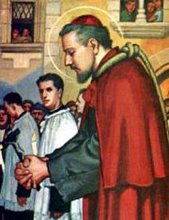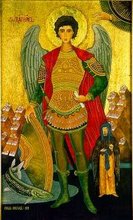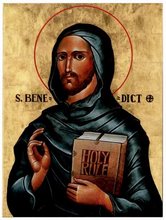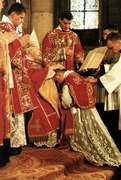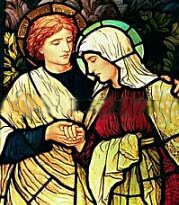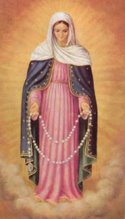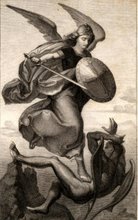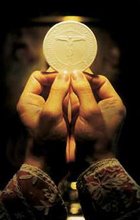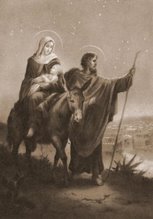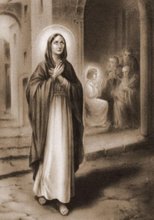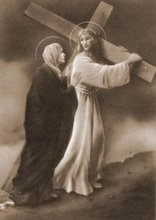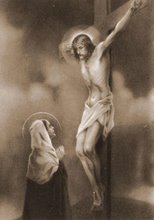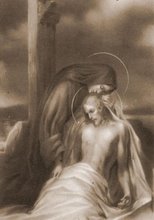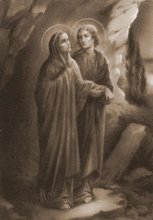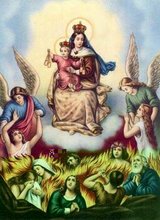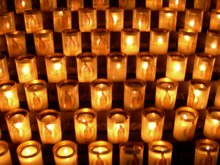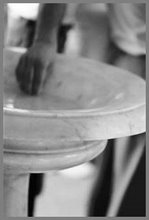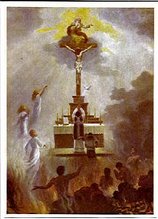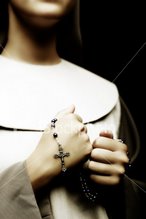








Holy Agnes was martyred on 21st January c305 AD in the Piazza Navona in Rome, at the tender age of twelve or thirteen. The son of the Governor of Rome proposed marriage, but Agnes preferred virginity. Her refusal to accept his hand, sent the Governor into a rage, and he threatened to expose Agnes’s parents as Christians, and so face certain death. He tried to persuade Agnes to change her mind by making her walk naked through the city, but her hair miraculously grew to cover her body and save her nakedness. This could not change her mind, so Agnes was burned at the stake, but the flames refused to touch her. She was sent to the lions, who made no attack on her. The son of the Governor goaded the lions who then attacked and killed him. The Father, distraught at his son’s death, pleaded with Agnes to pray for him, and at her intercession he was restored to health. Undeterred, the Governor had Agnes beheaded. Her body was buried in the Catacombs outside the city. On the octave day, she appeared in a vision, full of assurance of her well-being.
Her preference of death, rather than any violation to her young sacred body won her much renown in the early Church, most especially in Europe.
Her severed head is in the Church of Sant’ Agnese in Agone in the Piazza Navona. Her body is in the Basilica of Sant’ Agnese fuori le Mura (St Agnes outside the Walls) on the Via Nomentana.
Because of the resemblance of her name, Agnes to agnus (latin for lamb) she is often represented in Art carrying a lamb. And, on her feast day in the Basilica of St Agnes the Holy Father blesses lambs, from which the sisters of St Agnes’ convent make the Sacred Pallia, worn by Archbishops. Once the Pallia are made, they rest above the tomb of St Peter in the Vatican, from where new Archbishops receive them from the Holy Father.
We celebrate with her and all the saints, their victory over death and suffering through Jesus. We also pray and hope that we will be amongst their number and remain loyal to the faith which she professed, live and died by.
Holy Agnes, pray for us and for my daughter until she stand beside you in heaven!





From Wikipedia: "The Wilton Diptych (c.1395-1399) is a small portable altarpiece of two panels. It is an extremely rare survival within England of late Medieval religious painting.
The diptych was painted for King Richard II of England who is depicted kneeling before the Virgin and Child in what is known as a "votive portrait".
The painting is considered an outstanding example of the International Gothic style and possibly of English art. It belongs to the National Collection and is currently housed in the National Gallery, London."
Here is entire left side of the diptych:
 "... the kneeling King Richard II is presented by the Saints John the Baptist, Edward the Confessor and Edmund the Martyr. In the right hand panel the Virgin Mary with the Christ Child in her arms is surrounded by eleven angels, against a golden background and field of delicately coloured flowers."
"... the kneeling King Richard II is presented by the Saints John the Baptist, Edward the Confessor and Edmund the Martyr. In the right hand panel the Virgin Mary with the Christ Child in her arms is surrounded by eleven angels, against a golden background and field of delicately coloured flowers." Interpretation: The identity of the kneeling king is known because the angels surrounding the Virgin are wearing the livery of Richard II, the White Hart, which also appears in the brocade of the left panel and the outside of the diptych. As Richard kneels, the Christ Child reaches towards him in benediction and also reaches towards the pennant held by an angel, and significantly placed between them. This pennant is the symbol of Richard's kingship and of the Kingdom of England as a whole, It bears the Cross of St. George, the symbol of England and furthermore surmounting the staff is an orb on which is tiny map of England.
Interpretation: The identity of the kneeling king is known because the angels surrounding the Virgin are wearing the livery of Richard II, the White Hart, which also appears in the brocade of the left panel and the outside of the diptych. As Richard kneels, the Christ Child reaches towards him in benediction and also reaches towards the pennant held by an angel, and significantly placed between them. This pennant is the symbol of Richard's kingship and of the Kingdom of England as a whole, It bears the Cross of St. George, the symbol of England and furthermore surmounting the staff is an orb on which is tiny map of England.
All three saints who present the kneeling Richard to the Virgin and Child are believed to have been venerated by the king, as each has his own chapel in Westminster Abbey. Each saint holds the symbollic attribute by which they are recognised in art. Edmund the Martyr, who stands to the left, holds the arrow which killed him in 869, while Edward the Confessor, at the centre, holds the ring he gave to a pilgrim who transpired to be the disguised John the Evangelist. John the Baptist (right) holds his symbol, the Lamb of God.
The image on the left makes reference to King Richard's birth on 6th January. This is the feast day that Christians celebrate Epiphany, when Christ was adored by three kings and also the baptism of the adult Christ with John the Baptist shown touching Richard's shoulder.
John the Baptist was Richard's Patron Saint, and Saint Edward and Saint Edmund had both been English kings. Richard had a special devotion to Edmund, who with St. George is one of the patron saints of England.
The painting is indicative of both Richard's belief in his divine right to rule and his genuine Christian devotion. It also importantly symbolises (in the form of the Pennant), Richard II giving his kingdom into the hands of the Holy Virgin, thereby continuing a long tradition by which England was known as "Our Lady's Dowry" and was thought to be specially under her protection
(source)

The king's body was ultimately interred at Beadoriceworth, the modern Bury St Edmunds. The shrine of Edmund soon became one of the most famous and wealthy pilgrimage locations in England and the reputation of the saint became universal.
 (photo credit)
(photo credit) The date of Edmund's canonization is unknown, although Hermann's Life of Edmund, written in the late eleventh century, states that it happened in the reign of Athelstan (924–939). Edmund's popularity among the English nobility was lasting. It is known that his banner was borne in the Irish expedition of the Anglo-Normans and also when Caerlaverock Castle was taken in 1300. A banner with Edmund's crest was also carried at the battle of Agincourt. Churches dedicated to his memory are found all over England, including St Edmund the King and Martyr in London. There are a number of colleges named after St Edmund. His shrine at Bury St Edmunds was destroyed in 1539, during the English Reformation. His feast day is 20 November.

Next posts will be about the famous Wilton image and the fascinating "Legend of St. Edmund"
 Here is a medieval drawing of St. Edmund. Edmund was king of East Anglia before England was united as one sovereign country. At the time, the British isle was subject to frequent and devastating raids by Vikings from Scandinavia. Usually the British people would pay tribute, or rather simply pay the Vikings off to avoid being pillaged. Edmund died a martyr. Imagine, a King of England dying for his Catholic faith.
Here is a medieval drawing of St. Edmund. Edmund was king of East Anglia before England was united as one sovereign country. At the time, the British isle was subject to frequent and devastating raids by Vikings from Scandinavia. Usually the British people would pay tribute, or rather simply pay the Vikings off to avoid being pillaged. Edmund died a martyr. Imagine, a King of England dying for his Catholic faith. St. Edmund, Martyr ~ Icon. You can see here the instruments of his martyrdom, the arrows. Also you see a wolf cradling a severed head. See next post for this story.
St. Edmund, Martyr ~ Icon. You can see here the instruments of his martyrdom, the arrows. Also you see a wolf cradling a severed head. See next post for this story. St. Edmund's ~ Coat of Arms
St. Edmund's ~ Coat of ArmsSt. Edmund -Ora Pro Nobis!
(Source)


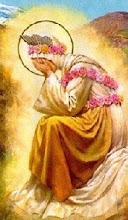
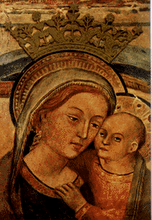
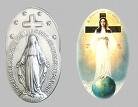
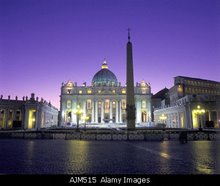
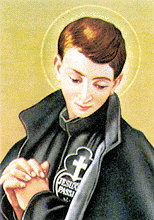
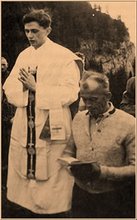
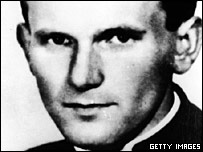
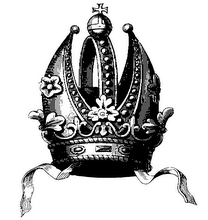
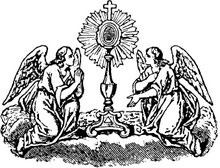
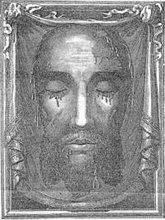
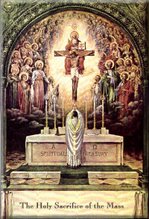

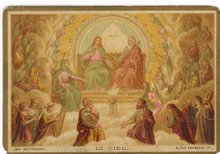

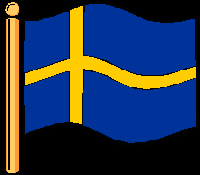

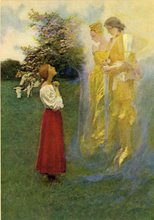
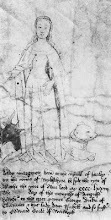01.jpg)


